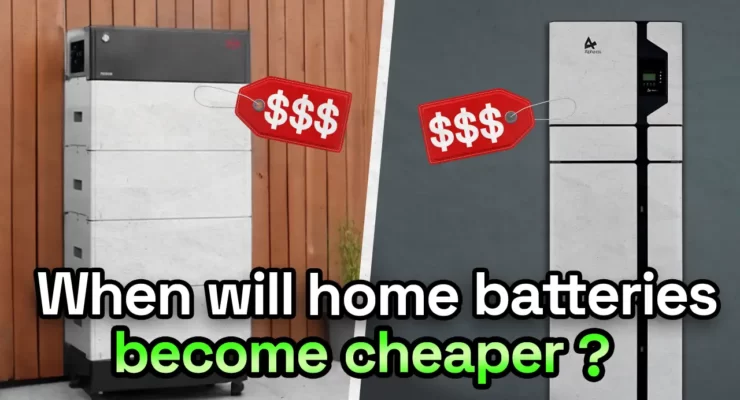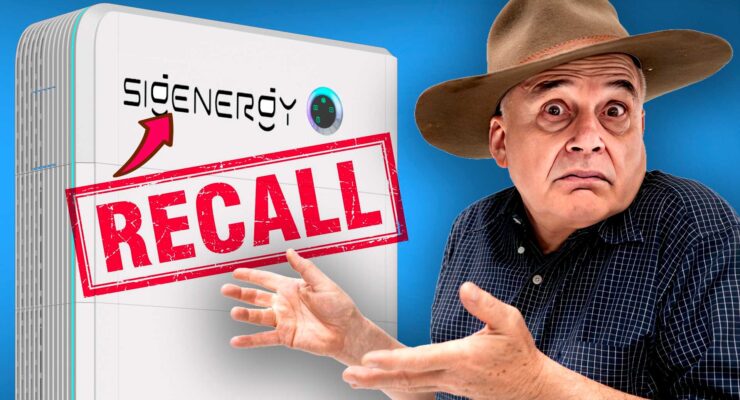
Fast read
As they enable the storage of extra solar energy that may be used when the sun is not shining, solar batteries are a crucial part of the transition to renewable energy. Unfortunately, solar battery prices have remained high rather than falling as anticipated since the demand for electric vehicles (EVs) is now outpacing that for solar batteries.
Since lithium is in such high demand due to the expansion of the EV market, mining is necessary to produce lithium-ion batteries, the most common type of home solar storage battery.
New mining projects are being created to improve supplies, but they will take some time to completely operational.
To reduce the price of solar batteries, new battery technologies that use fewer raw materials and are more widely accessible might be required.
Are solar batteries going to be affordable in the future?
In Australia, 3 million solar systems are on the roofs. Manufacturing has come down, so we consume less electricity in this sector. So we have all this renewable solar electricity in the middle of the day. So home storage batteries would be excellent, and to get a more considerable uptake, we need solar batteries to become more affordable.
Using solar battery storage helps manage power availability throughout the day. However, a challenge arises as the demand for solar batteries and electric vehicles (EVs) grows simultaneously. This dual demand is affecting the expected drop in solar battery prices.
Two years ago, I got a Tesla Powerwall 2 home battery for $13,500. In 2022, the same battery, with the same features, has an upfront cost of $16,000. The only change is the addition of software upgrades.
This $2,500 increase raises concerns about the expected decrease in solar battery prices. The link between the increasing popularity of EVs and the demand for solar batteries seems to be affecting pricing. This shows how the clean energy market is connected and the challenges in reducing costs as anticipated.
To make informed decisions, consumers need to stay updated on market trends, pricing changes, and factors affecting solar battery costs. Despite these challenges, the long-term benefits, like energy independence and sustainability, make investing in solar batteries attractive. Staying informed about industry changes can help consumers navigate this evolving landscape.
I thought solar batteries would become affordable
I was told that batteries would follow the solar panel and inverter price curve, meaning when production numbers increase, production costs come down, and the product will be cheaper for end consumers.
Regarding our transition from fossil fuel-based energy to renewable energy. Batteries play a vital role, as without them, we can not utilise renewables when the sun does not shine, and the wind does not blow.
Regrettably, battery home storage products are still considered quite unaffordable. This means bringing cheaper home batteries to the market or providing government subsidies is urgent.
Right now, when one multiplies the electricity bill savings because of the home battery. For our sample household, the cost would be $800 per year, with the life of the battery – let’s say 11 -12 years, resulting in $9600 in total savings over the life of the battery.
This $9,600, unfortunately, does not cover the initial outlay of a 10 to 16kWh battery for $10,000 to $16,000. Maybe these numbers will change over the next few years if electricity prices keep increasing at the current rate. So to progress to a more sustainable energy landscape, affordable solar batteries are a must.
While many types and brands of solar batteries are on the market, they all have one similarity.
The reason solar batteries are still not affordable
Lithium-ion batteries are the most popular type of home solar battery system in the market today. Tesla, Panasonic, Sungrow, and BYD batteries all use lithium-ion in their manufacturing. However, lithium needs to be mined and the number of working mines is still restricted. Electric vehicle batteries in their raw material use the same raw materials as home storage batteries.
With the rapid growth of electric vehicle demand worldwide, the need for lithium-ion batteries has increased significantly, and so have prices, making them less affordable. As a result, it is pretty difficult for a relatively small home storage battery manufacturer (other than Tesla and LG) to compete strongly with high-volume vehicle manufacturers such as Tesla, Toyota, or VW for raw materials.
While other technologies are available for home storage batteries, such as lead-acid, the performance is less efficient than the new generation lithium-ion products. In addition, while cheaper, lead-acid batteries also require regular maintenance, have a lower capacity for the same physical size battery, and experience a shorter lifespan.
Mining companies are now working worldwide to open new lithium mines and increase supply. Unfortunately, such large-scale mining projects take many years to develop fully, and supply is not keeping up with demand, leading to home battery price increases.

Will new battery technology solve the problem?
Unless new battery technology is coming onto the market requiring less scarce raw materials and being available at a lower price point, the timeframe for seeing many Australian homes adding a storage battery could be a decade or more.
This is not desirable, as this will slow the transition from fossil fuels to renewable power. So we are stuck till the Federal Government finds a way to help Australians acquire more affordable solar batteries.
Maybe one solution would be a means-tested healthy Government rebate. For example, when the Howard Government in 2008 offered an $8000 rebate to get the solar industry moving, no one would have imagined that around 15 years later, over 3 million homes would have a solar system, with the highest residential solar systems penetration in the world and a healthy local renewable energy industry.
But, the more homes buy storage batteries, the more we could see a product supply shortage. Furthermore, the demand for raw materials will add to the price point, which means fewer consumers can afford solar batteries—a problematic situation.
Maybe there is a valuable lesson on how to speed up our transition to renewables with the help of targeted Federal Government initiatives.
What’s the future?
Solar batteries, which help store energy from the sun, are not getting cheaper in Australia. Even though many homes have solar panels, the prices of batteries are not going down as expected. This is because more people are also buying electric cars, and this high demand is keeping the prices up.
For example, two years ago, a Tesla Powerwall 2 battery cost $13,500, but now it’s almost $16,000, even though it’s the same thing with just some software upgrades.
The hope was that, like solar panels, battery prices would go down as more people buy them. But that’s not happening yet, and it’s a problem because if batteries are too expensive, not many people can afford them.
The main reason for the high prices is that most batteries use a material called lithium-ion, and there’s not enough of it. This material is also used in electric car batteries, and since more people are buying electric cars, the demand is high, making the prices go up.
Even though there are other types of batteries, they are not as good as lithium-ion batteries. Lead-acid batteries, for example, are cheaper but need more maintenance and don’t last as long.
Opening new mines to get more of the materials needed for batteries takes a long time. So, unless there’s a new kind of battery that doesn’t need these scarce materials, it might take more than ten years for batteries to become affordable for many Australian homes.
In summary, while solar batteries are not getting cheaper as quickly as expected, the future depends on finding new technologies, getting more materials, and government support. These factors will decide how soon solar batteries become affordable and help more people use clean energy.


